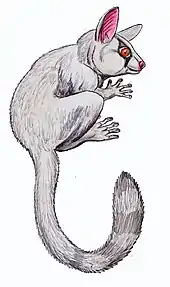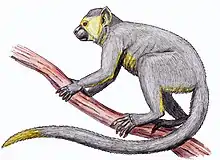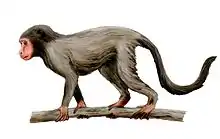Panamacebus
Panamacebus is an extinct genus of monkey known from the Early Miocene (Hemingfordian in the NALMA classification) of central Panama.[1]
| Panamacebus | |
|---|---|
| Scientific classification | |
| Kingdom: | Animalia |
| Phylum: | Chordata |
| Class: | Mammalia |
| Order: | Primates |
| Suborder: | Haplorhini |
| Infraorder: | Simiiformes |
| Family: | Cebidae |
| Genus: | †Panamacebus Bloch et al. 2016 |
| Type species | |
| †Panamacebus transitus Bloch et al. 2016 | |
Description
Together with Paralouatta marianae from Cuba, it is the oldest known New World monkey of North America.[2] Fossils of Panamacebus, a left upper first molar and lower premolar,[3] were uncovered from the Las Cascadas Formation, of which tuffs were analyzed providing an age of 20.93 ± 0.17 Ma,[4] of the Panama Canal Zone.[5]
References
- Panamacebus at Fossilworks.org
- Silvestro et al., 2017, p.14
- Bloch et al., 2016c, p.1
- Bloch et al., 2016b, p.6
- Bloch et al., 2016a, p.243
Bibliography
- ; ; ; ; ; ; ; , and . 2016a. First North American fossil monkey and early Miocene tropical biotic interchange. Nature 533. 243–246. Accessed 2019-02-14.
- ; ; ; ; ; ; ; , and . 2016b. Panamacebus - Supplementary Methods and Results. Nature 533. 1–28. Accessed 2019-02-14.
- ; ; ; ; ; ; ; , and . 2016c. Panamacebus - Supplementary Figures. Nature 533. 1–10. Accessed 2019-02-14.
- ; ; ; ; ; ; ; , and . 2017. Evolutionary history of New World monkeys revealed by molecular and fossil data. BioRxiv _. 1–32. Accessed 2017-09-24.
This article is issued from Wikipedia. The text is licensed under Creative Commons - Attribution - Sharealike. Additional terms may apply for the media files.



